|
On the last Wednesday of every month, I serve up a potpourri of advice, inspiration and other tidbits I've come across in recent weeks. Here's this months' serving of Last Wednesday Wisdom. As always, you get a reward for reading to the end, this time, a preview of coming attractions! What is life? It is the flash of a firefly in the night. It is the breath of a buffalo in the wintertime. It is the little shadow which runs across the grass and loses itself in the sunset. -- Crowfoot, (ca 1830-1890), Blackfoot warrior and orator We must always change, renew, rejuvenate ourselves; otherwise, we harden. -- Johann Wolfgang von Goethe Once someone asked a well-known Thai meditation master, "In this world where everything changes, where nothing remains the same, where loss and grief are inherent in our very coming into existence, how can there be any happiness? How can we find security when we see that we can't count on anything being the way we want it to be?" The teacher, looking compassionately at this fellow, held up a drinking glass that had been given to him earlier in the morning and said, "You see this goblet? For me, this glass is already broken. I enjoy it. I drink out of it. It holds my water admirably, sometimes even reflecting the sun in beautiful patterns. If I should tap it, it has a lovely ring to it. But when I put this glass on a shelf and the wind knocks it over, or my elbow brushes it off the table and it falls to the ground and shatters, I say, 'Of course.' When I understand that this glass is already broken, every moment with it is precious. Every moment is just as it is, and nothing need be otherwise." -- Stephen Levine in Who Dies?: An Investigation of Conscious Living and Conscious Dying (Anchor, 1982) The intellect can understand a story--but only the imagination can tell it. -- Stephen Koch in The Modern Library Writer's Workshop: A Guide to the Craft of Fiction (Modern Library Paperbacks, 2009) He who has made a thousand things and he who has made none, both feel the same desire: to make something. -- Antonio Porchia I love my rejection slips. They show me I try. -- Sylvia Plath Be joyful/though you have considered all the facts. -- Wendell Berry (in "Manifesto: The Mad Farmer Liberation Front:)
8 Comments
In honor of the first day of summer, I'm sharing a piece I wrote some years ago in celebration of the season. In warm weather, I ride my motorcycle down out-of-the-way roads I have no reason to travel the rest of the year. Along one shady stretch, just beyond a curve, is a place that stirs my imagination. What intrigues me isn't the low-slung house with the wraparound deck and picture windows or the wooded lot with the gazebo down by the stream. It's the sign the owners have posted out front. Artfully lettered and painted with flowers, it reads: "Enjoy summer! The Finkbeiners."  I don't know the Finkbeiners. I doubt we'll ever meet. But it pleases me—as I whiz past with the wind stroking my bare arms and singing in my ears—to think that someone inside endorses my enjoyment. I stop feeling guilty about dodging deadlines and leaving a pile of dirty dishes in the sink. I'm having a good time, and that's just fine with the Finkbeiners. 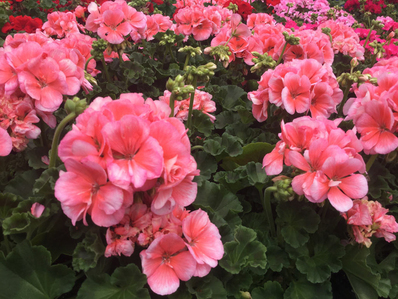 But here's the odd thing: No matter how often I pass the Finkbeiner place and how closely I scrutinize the surroundings, I never actually see a Finkbeiner enjoying summer. I see all the trappings of a darned good time. There are lounge chairs and a barbecue grill on the deck. There are pots of pink geraniums. But it concerns me that these folks who've gone out of their way to urge the rest of us to make the most of this fleeting season may not be taking advantage of all it has to offer. Sometimes I daydream about pulling into the Finkbeiners' driveway, getting off the bike, knocking on their door and asking how things are going and why, by the way, they're so preoccupied with everyone else's pleasure when they don't seem to care a whit about their own. But then I worry that perhaps there's some awful reason, like a debilitating illness or the untimely death of a loved one, why the Finkbeiners aren't having much fun these days, even while continuing to hope that the rest of us are.  Other times I imagine a perfectly healthy and content Finkbeiner, iced tea in hand, answering my knock but glaring suspiciously through the screen at me—a stranger at the door with no package to deliver or petition to sign, simply someone who shows up unannounced on an August afternoon, asking impertinent questions. The encounter might not go well at all, and I might leave with the hollow sense that the Finkbeiners really don't care how my summer goes.
 Then one day the Finkbeiners happen to drive by, on their way from their new home to an eye appointment or the wedding of someone's son. They see us lolling or frolicking or whooping, and they read our sign: "Have a super summer!" And I dream that they do. How will you make the most of summer?
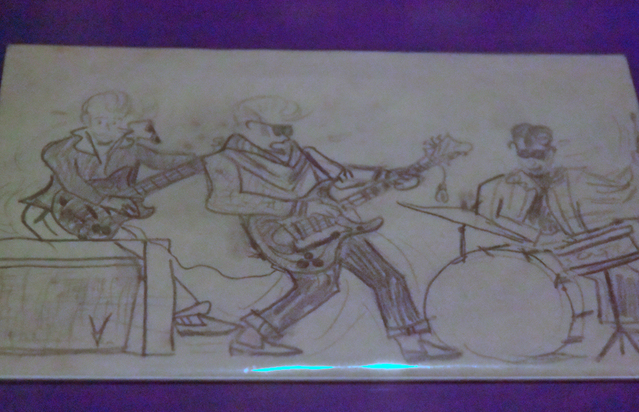 The drawing you see here was done by a boy in his early teens, in the mid-1950s. Not so unusual in itself—countless boys have made similar drawings of rock bands. But what earned this drawing a place in a museum was the particular young artist who created it: James Marshall Hendrix, born Johnny Allen Hendrix, known to most of us as Jimi Hendrix. 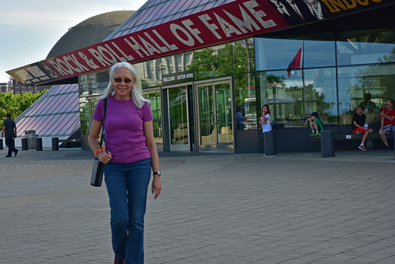 I learned of Jimi's early artistic leanings on a recent trip to the Rock and Roll Hall of Fame in Cleveland, where the drawing is displayed. According to the accompanying text, Hendrix once dreamed of being a commercial artist. His father recalled that Jimi never had art lessons, but "he had a good hand and his ideas and imagination." 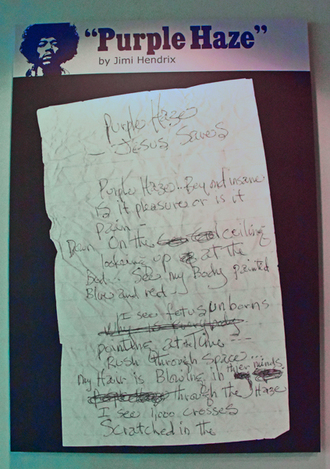 No kidding. Jimi's good hand, ideas and imagination, applied to music, were nothing short of mind-blowing. Kinda makes you glad that commercial art thing never panned out. People like Jimi Hendrix, whose creativity crosses boundaries—from visual to verbal to musical to culinary--fascinate me, and like anything, once you start looking, examples are everywhere.  I found another at Rock Hall, in an exhibit on Graham Nash and his passion for making music and art—from his early days as a founding member of the Hollies to his years with Crosby, Stills, Nash & Young, to his later work as solo artist and photographer. Like Hendrix, Nash traces his interest in visual arts to childhood, when photography captured his imagination. Later, he not only made his own photos and experimented with digital imaging, he also collected photographs and other artifacts from the intersecting worlds of art, rock music and politics. I had never thought of collecting as a creative outlet, but a quote from Nash in the exhibit made it clear that he does. Unfortunately I didn't write down the quote (blame sensory overload and the approaching lunch hour), but it was something to the effect that he tries to engage in some creative activity every day; if he's not writing a song, he's making photographs or painting or collecting.  Not a bad way to live, whether or not you consider collecting a form of creative expression. (And I admit, after reading Nash's quote, I'm trying to look differently at Ray's habit of coming home from every trip to Harbor Freight with yet another free tape measure. That stash of nearly forty tape measures in his workshop is not a sign of hoarding, it's creative genius at work.) Turns out, it's not just my husband and rock stars who practice crossover creativity. Many poets and authors regularly mix media. For example:
Reading about all these multiply-creative people absolves my guilt (if I ever had any) for leaving my writing desk and walking into the woods with my camera or hauling out my collage-making materials. These excursions into other art forms aren't procrastination or dilettantism, they're simply alternate ways of expressing myself. And while I'm exploring those alternatives, maybe I'll swing by Harbor Freight and pick up a few tape measures to add to Ray's collection. It's a creative thing. What's your creative thing, and how can you step beyond its boundaries?
 Do you flourish in the swirl of chaos, or does disorder derail you? I put the question to friends recently, and their answers surprised—and reassured—me. As someone who's been teased about excessive organization (my label maker is the first thing I'd rescue from a fire), I've always felt my need for order was a character flaw—a sure hallmark of an unimaginative dullard. The truly creative thrived on mental and physical messiness. Or so I'd been led to believe. So imagine my surprise when many of my most inventive and original friends confessed they prefer order over disarray—at least some of the time.  Susan Stec: orderly writing life, riotous fiction Susan Stec: orderly writing life, riotous fiction One person I'd thought for sure would come down on the side of chaos is my writing pal Susan, a mile-a-minute talker who writes highly imaginative paranormal romance, urban fantasy humor and horror books populated with an uninhibited bunch of characters in riotous situations. I kinda figured her life must be like her books. But no, when Susan summons the muse, she wants order (though she does admit to revving herself up with old rock music). 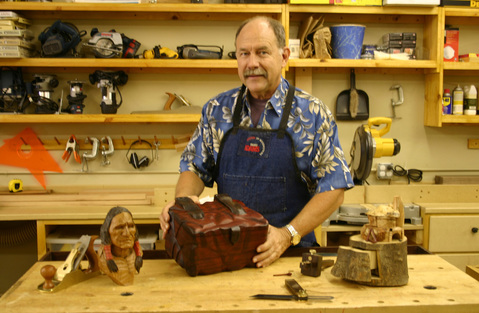 Van Odell in his woodworking shop. Not, at the moment, stirring sawdust. Van Odell in his woodworking shop. Not, at the moment, stirring sawdust. Van, a school-days chum who builds fine furniture in his spare time, concurs. Without the utmost tidiness, he says, "I just stir the sawdust and rethink the design for hours." 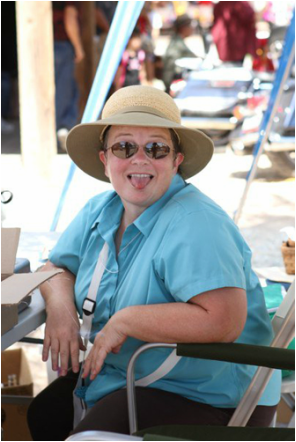 Rebecca. (No further description necessary, right?) Rebecca. (No further description necessary, right?) Then there's the practical side of the question. "I can't find things, I get cranky," says Rebecca, who has a degree in library science and a reputation for organization (bet she loves her label maker, too), but also a mad creative streak (somewhere I still have the carrot-shaped hand puppet she made when we were roomies in Detroit). Okay, I feel better knowing I'm not the only one who finds comfort in order. But what about the notion that chaos feeds creativity? It's not a myth—there's research to back it up. A study published in Psychological Science a few years ago found that although working in a tidy environment encouraged people to do responsible things like eating healthfully and giving to charity, working in a messy space stimulated their creative juices. The experiment by psychological scientist Karen Vohs and colleagues worked like this: participants were divided into two groups, with one group assigned to an orderly room and the other group assigned to a room with books and papers strewn about. The researchers asked both groups to work for a while in their assigned rooms, filling out questionnaires unrelated to the study. Afterward, all subjects were given a chance to donate money for books and toys for children. And as they were leaving, all were offered a snack of either a candy bar or an apple. The results were clear: 82 percent of those who'd worked in the tidy room donated money, compared to only 47 percent from the messy room. And 67 percent of the neat room folks chose an apple over chocolate, while only 20 percent of the messy-room workers made that choice. 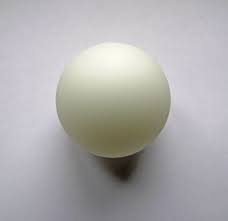 But look what happened when the researchers conducted an identical experiment with a different challenge at the end: thinking up novel uses for a ping pong ball. The messy-room and neat-room participants came up with the same number of ideas, but an independent panel of judges rated the messy-room workers' ideas as significantly more creative. Indeed, being willing to make a mess is key to breaking new ground, notes innovation consultant Linda Naiman in her Creativity at Work blog. "Chaos is part of the creative process, and you miss out if you avoid it."  Malcolm Gladwell Malcolm Gladwell Naiman's blog post, which includes a video clip of journalist and author Malcolm Gladwell expounding on embracing creative chaos, ends with this quote from Friedrich Nietzsche: "You must have chaos within you to give birth to a dancing star." Note the word within. I read in a Scientific American blog post that brain researchers recognize two crucial brain networks for creative thought: the Executive Attention Network, which gets busy when cognitive control is needed, and the Imagination Network (also known by the too-boring-for-something-so-cool name Default Mode Network), which retrieves personal past experiences and other long-term memories and also is involved in thinking about the future and imagining alternative scenarios to the present. Daydreaming type stuff, in other words. Studies show that the Imagination Network is highly active during creative thinking. But there's also a need for controlled attention—the business of the Executive Attention Network—to make sense of the jumble of ideas the creative mind comes up with. "I like to think of creative cognition as controlled chaos because it incorporates both elements of the creative process," writes Scott Barry Kaufman, executive director of the University of Pennsylvania's Imagination Institute, in the Scientific American blog piece. "Cognition that is merely controlled is rigid and colorless. Cognition that is pure chaos is bizarre. But we owe some of the greatest inventions of all time to cognition that is both controlled and chaotic." My friends and I don't claim to be coming up with the greatest inventions of all time, but that's pretty much the conclusion we've arrived at. There's a need for balance between chaos and order. Here's Rebecca, the puppet-making library science grad: "If we want to get Hegelian, the sequence is thesis, antithesis, synthesis, so we need a little chaos in the middle in order (ha!) to get to the innovation/synthesis part."
" The whole thing is a joy, and that same order-chaos-order process seems to work for many of my creative friends, judging from their responses to my question. Diane, for example, is a Feng Shui consultant whose latest projects—helping prepare Red Fox Market in Big Rapids for opening and creating a fairy house for Camp Newaygo's Enchanted Forest event—are all about "creating spaces to reflect what one wants to 'feel' in their life." She puts it this way:  Diane Sack Diane Sack "Totally love the order that comes through chaos! Whether creating a huge mess, or just finding oneself in the middle of a chaotic life, the feeling of satisfaction and calm joy surfaces once all is clean, organized and less stressful. Love the process of it all." So here, to me, is the bottom line: You don't have to a slob to be creative, you only have to be willing to get messy sometimes. Just make sure you choose your snacks after you've cleaned up the mess. Agree? Disagree? Where do you fall on the order-to-chaos continuum, and how do you think your position on the scale affects your creativity?
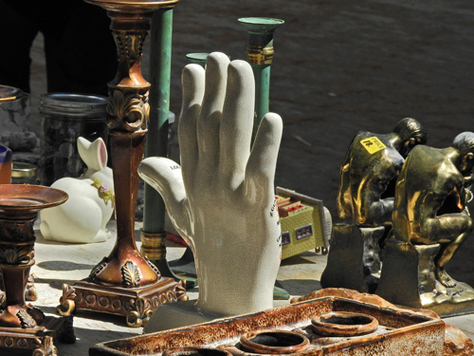 For inspiration, entertainment and even a bit of exercise, nothing beats a day at the flea market—especially if it's Burley Park flea market in Howard City, Michigan, with its 600 dealer spaces spread over a partially pine-shaded park.  The flea market happens five times a year: Memorial Day, July 4, the first Sunday in August, Labor Day and the first Sunday in October. All winter long, Ray and I look forward to the Memorial Day market, which is usually the biggest. Apparently, a lot of other people look forward to it all winter, too. Just look at the crowd that was lined up when we arrived soon after the gates opened at 8 a.m.
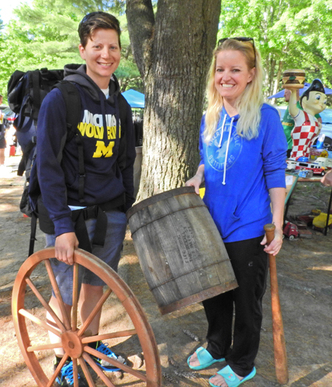 I met shoppers Brie and Chelsea as they were lugging an old wooden wheel and a weathered nail keg toward the exit. The barrel will hold strawberry plants, Chelsea said, and the wheel is "just a decorative piece," Brie added. I didn't think to ask about the baseball bat. But then, sometimes a bat is just a bat. 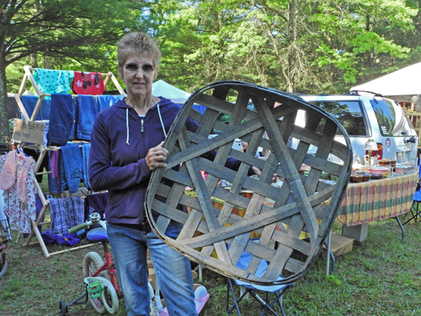 Marilyn was carting off a handsome baskety-looking thing that was nearly as big as she was. "It's a tobacco basket," she told me, and she pointed in the direction of a vendor selling a large selection of them. She figured it would make a striking wall decoration for her primitive-themed home. Sure would! I've seen pictures of similar ones hung over fireplaces or chests, sometimes with additions of dried flowers, old photographs or mirrors, but just as attractive unadorned. The wagon-load of stuff Connie was toting caught my eye. She plans to use the old tricycle as a garden decoration. The other odds and ends will find homes as accent pieces on shelves. 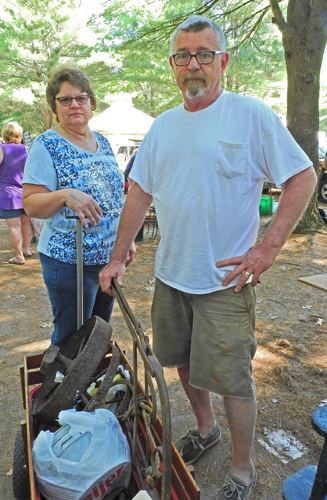 Andy and Christy had a wagon-load of intriguing stuff, too. I could imagine plenty of uses for the rusty metal wheels. But what was that other thing that looked like a rickety iron headboard? "A hay grapple," Andy explained, once used for snagging hay bales and lifting them into a barn loft. Okaaaaay . . . but what on earth could you do with such a thing if you weren't hauling hay? Andy whipped out his phone and showed me a picture of a very cool-looking wall shelf he made with a similar one. (If he emails me the photo as he said he would, I'll share it with you here.) 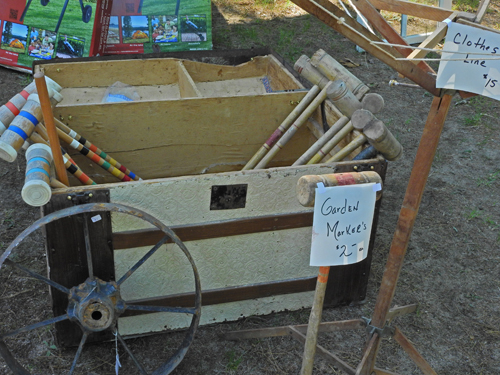 Some vendors spur shoppers' imaginations by suggesting new uses for the cast-offs they're peddling: croquet mallets as garden stakes, for example. Barb and Denny even provided examples of what to do with the rusty bed springs they were selling. The springs came from an old bed in Denny's grandfather's house in Pennsylvania. The couple disposed of the straw mattress and kept the iron bedstead and old springs. For a while, Denny pulled the set of springs behind a tractor to prepare garden soil. Then Barb saw some clever uses of old bed springs on Pinterest and that was the end of their life as garden harrow. She cut out the individual coils,, made a display of springy crafts and offered the rest for sale. Jodi went a step further, offering recycled crafts themselves for sale. I guess that made sense, given that her starting material was empty half-gallon rum bottles. Not a great demand for those, even at a flea market. With some stones, twine, buttons and Popsicle sticks, she transformed the bottles into decorative birdhouses. "Kept me busy all winter," she said. If they didn't sell, no big deal – she'll give them as Christmas gifts. We wandered up and down aisles for more than five hours (that's where the exercise comes in), feeling alternately inspired and overloaded by the sheer quantity of stuff to look at. There truly was something for every taste: whimsical . . . goofy . . . jolly . . . and macabre! 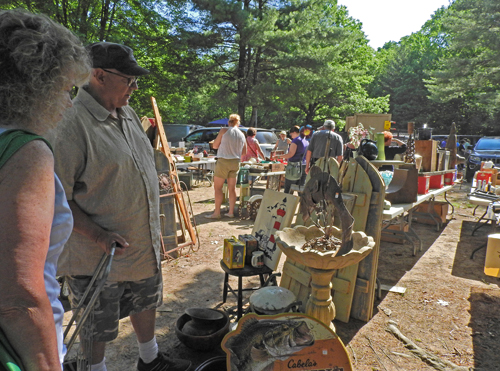 Another source of amusement is listening to (okay, eavesdropping on) conversations about things people are considering buying. Most run along the lines of "What are you going to do with that?" and you can tell by the inflection who's talking to whom. If you hear, "What are you going to do with that?" it's likely a conversation between two strangers who are buying similar items. On the other hand, "What are you going to do with that? is usually uttered by a spouse and often followed by "and where are you going to put it?" Shopping, imagining and eavesdropping get wearying after awhile, and to get through the whole market, a refreshment break is a must. We usually opt for the ice cream offered by Amish vendors who make it in old-fashioned churns powered by a steam engine. The clunky chug of the engine, audible from several aisles away, adds to the anticipation. Now that we're refreshed, it's your turn to shop. Stroll on and share your creative ideas for the things you discover.
|
Written from the heart,
from the heart of the woods Read the introduction to HeartWood here.
Available now!Author
Nan Sanders Pokerwinski, a former journalist, writes memoir and personal essays, makes collages and likes to play outside. She lives in West Michigan with her husband, Ray. Archives
April 2022
Categories
All
|













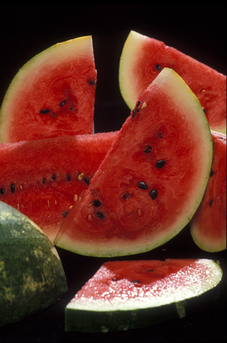
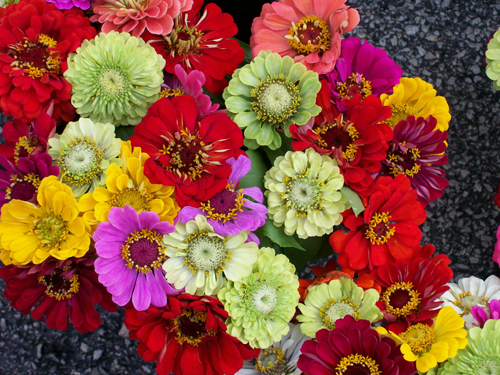





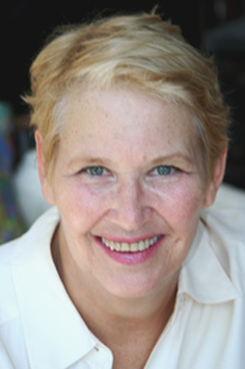






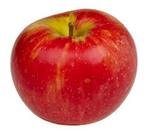
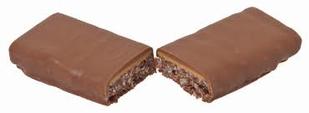


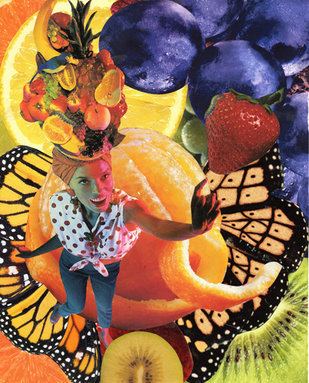
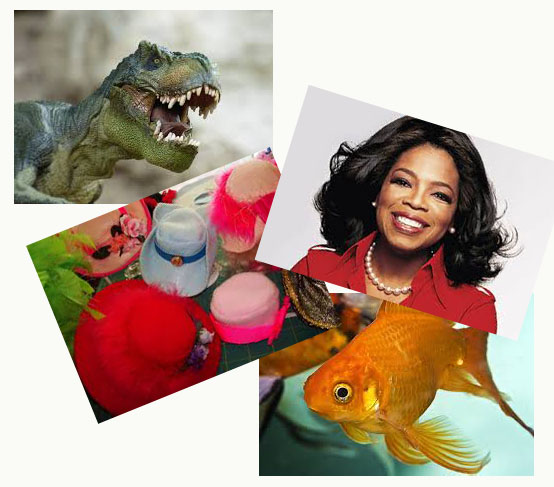
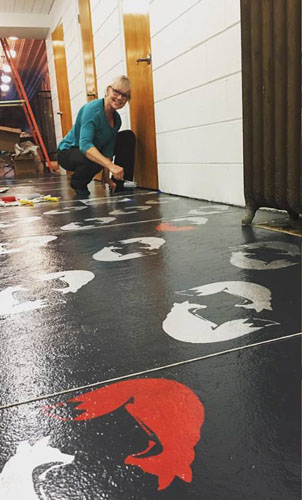
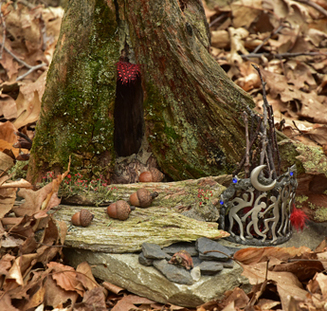
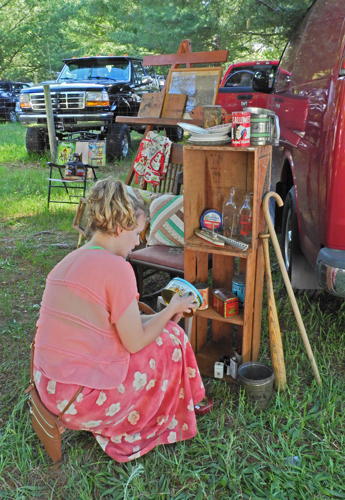

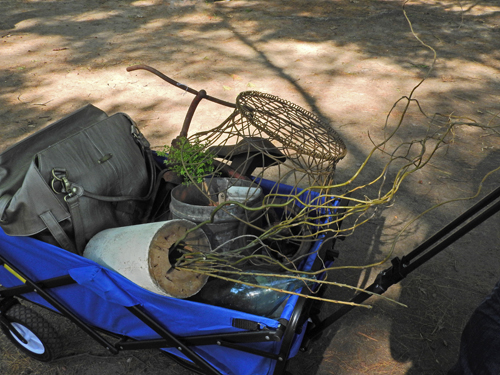
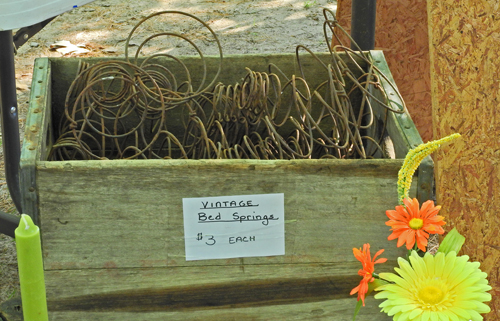
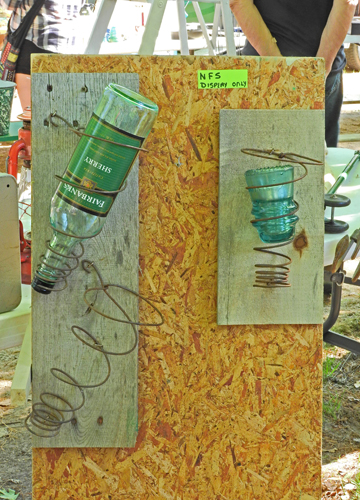
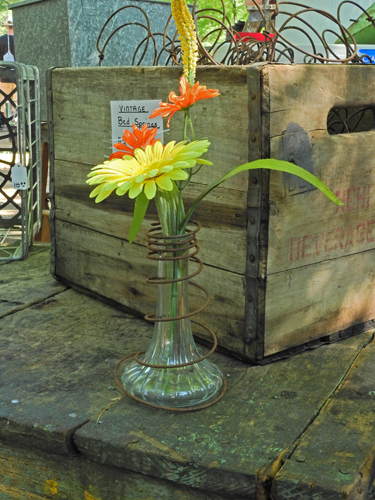
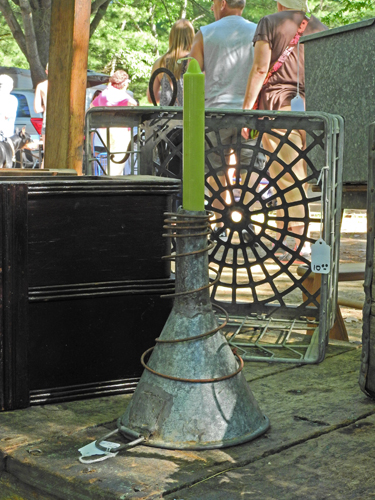
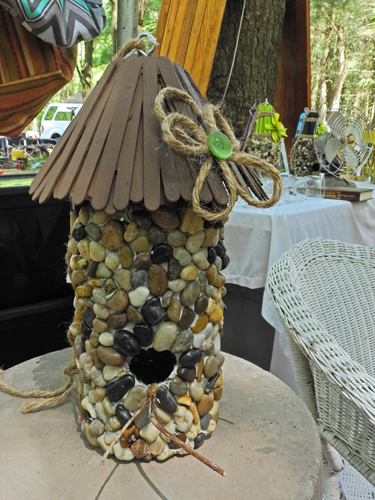
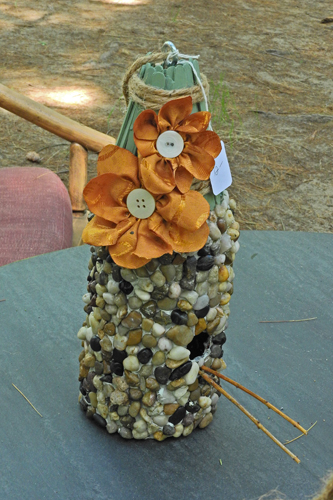

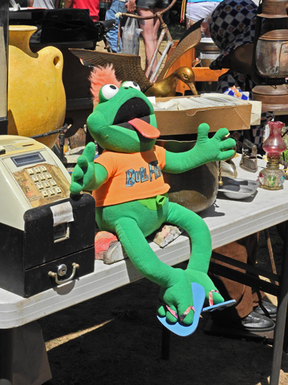
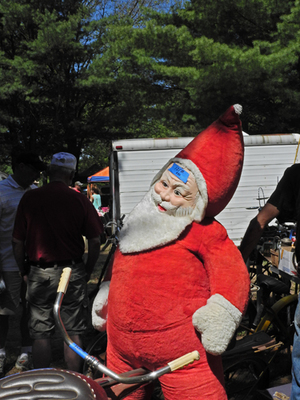
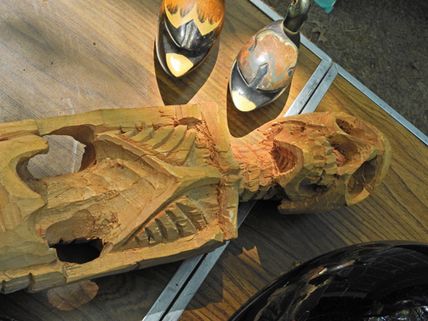
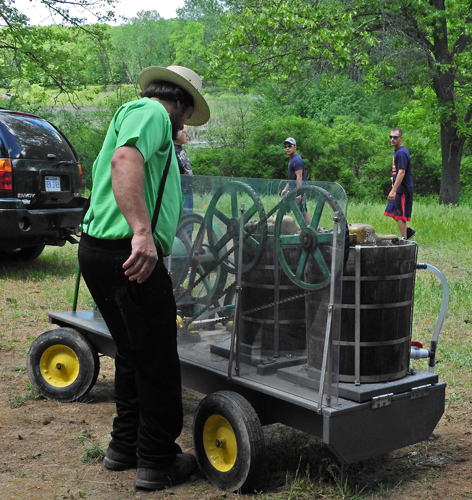
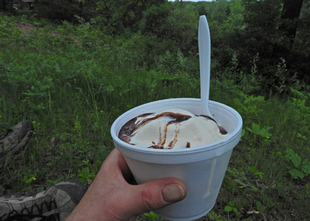

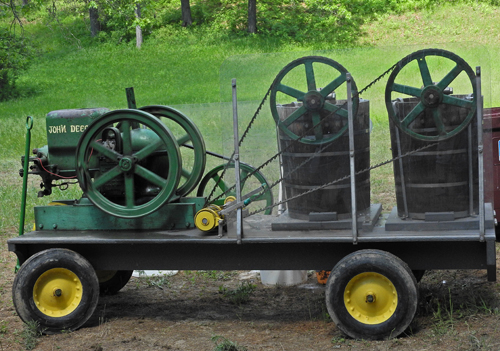
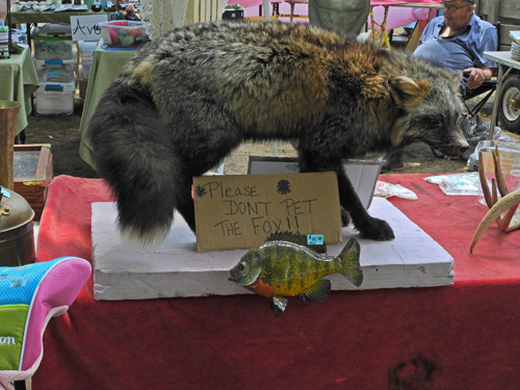
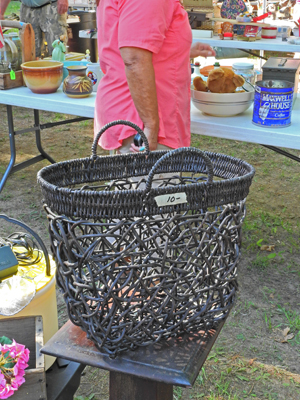
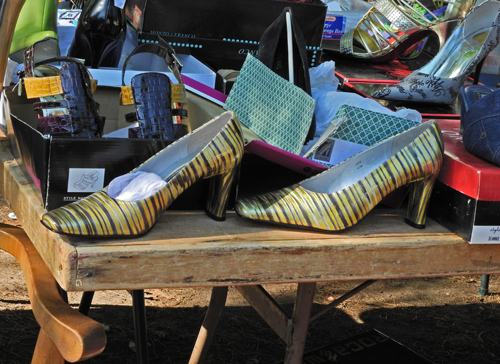
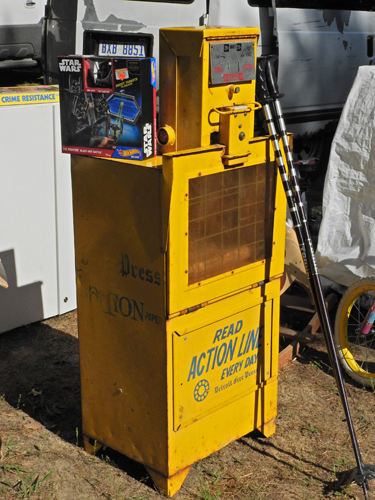
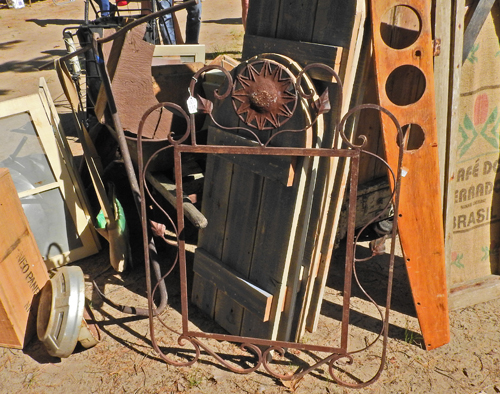
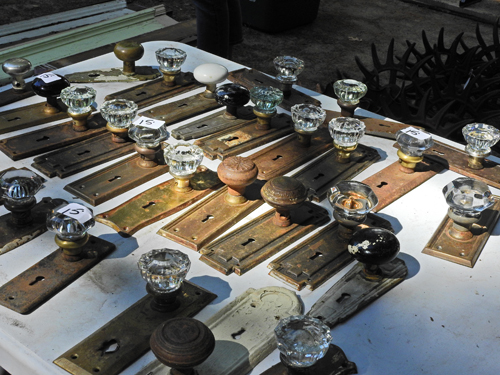
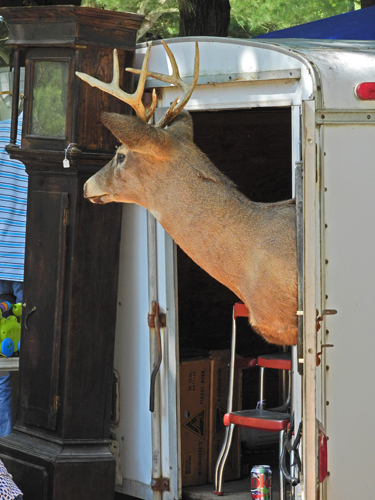
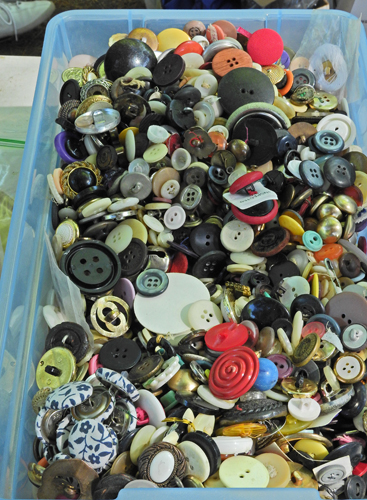


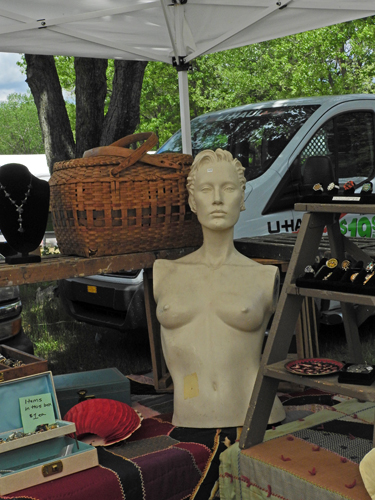
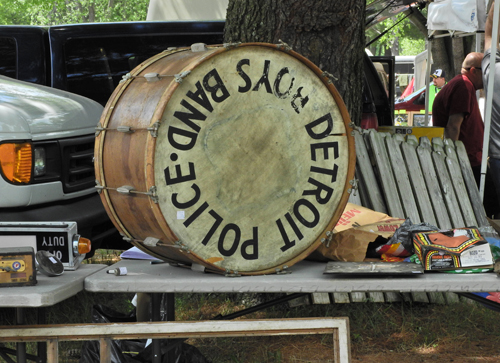


 RSS Feed
RSS Feed